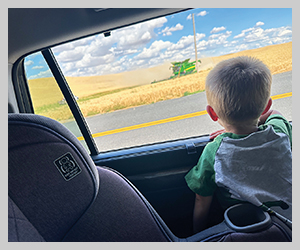Growing a new kind of crop Adding value to a commodity can boost producers' bottom lines, rural communities
2022August 2022
By Trista Crossley
Editor

Have commodity farmers become so efficient that they’re hurting themselves and the rural communities that they live in? Finding ways to add value to a crop could bolster the bottom lines of both.
 “We are producing more than we ever have before, and we are doing it cheaper than we ever have, so food prices are affordable, but that comes with a downside,” Rich French explained. “Farm employment has been reduced by about 90% because of new technologies that have come out. That’s fabulous for you and I as a buyer, but for small communities in the Palouse, you are reducing the number of jobs by 90%, so people are leaving, and the towns are shrinking, losing their grocery stores and banks. That is sad to see.”
“We are producing more than we ever have before, and we are doing it cheaper than we ever have, so food prices are affordable, but that comes with a downside,” Rich French explained. “Farm employment has been reduced by about 90% because of new technologies that have come out. That’s fabulous for you and I as a buyer, but for small communities in the Palouse, you are reducing the number of jobs by 90%, so people are leaving, and the towns are shrinking, losing their grocery stores and banks. That is sad to see.”
French is executive director of One Palouse, formerly the Palouse Knowledge Corridor, which is an economic development and entrepreneurship-focused organization in Moscow funded by Whitman and Latah counties, the Port of Whitman, the University of Idaho and Washington State University. In a region steeped in farming, it isn’t surprising that value-added agriculture is one of the initiatives One Palouse is currently pursuing.
Value-added agriculture means producers are adding additional value to their crop in one of two ways: either changing the state of their product after it is grown or changing the production of their product in a way that makes it more valuable. For wheat farmers, that could look like milling grain into flour and selling the flour or switching to organic production methods (organic products can usually be sold at a premium). Barley growers could malt their barley, and chickpea growers could start making hummus and selling it.
“From a wheat farmer’s perspective, they are obviously all about efficiencies and technologies, and that’s fabulous, but it limits their ability to add revenue, to add to their bottom line. Wheat prices are fixed. You are going to get what you get, but if you add that extra step to it, the returns can be quite large,” French said. “Malting your barley or if you were to mill your own grain and focus on that regional, ‘grow local, buy local, eat local’ type of thing, the margins are much higher, so it’s giving you more opportunity to grow and add to your bank account. Each one of these steps can create pretty large job growth in your community.”
French and representatives from the aforementioned entities have been attending ag industry meetings to spread the word about how producers can strengthen their bottom lines — and their rural communities — by finding ways to add value to their crops. The Washington Small Business Development Center is also a partner in the initiative and provides education, mentoring and networking assistance. Funding is generally done through traditional bank lending models, although there are some grants available.
Steven Peterson, an economics professor at the University of Idaho, compiled some statistics that are being used in the presentations. In 1776, 90% of jobs in the U.S. were farm jobs. In 1900, that percentage dropped to 37%, and by 2020, it had dropped to 1.4%.
Besides finding the best way to add value to their product, producers also need to consider where the funding will come from and where to find buyers. For a grain farmer who wants to turn their grain into flour, a big hurdle is the milling process. One solution, French said, could be through a group approach.
“I truly think the co-op model is the right approach, where a group of farmers come together and invest in a mill, and maybe the port is involved. The Port of Whitman is always interested in assisting in these types of growth opportunities,” he said. “We recommend a producer work with university Extensions, the counties or your port to find creative solutions. Instead of paying the costs to truck your grain to the river and then barge it to Portland, you could mill it and sell it locally. This will create local jobs and keep those dollars in your community.”
Barley (through craft beer) and grape growers (wineries) are perhaps the poster children for success in the value-added agriculture world, but opportunities aren’t just for the big guys. “If you grow asparagus, instead of just selling raw asparagus at the farmers market, pickling it and selling it as a finished product increases your margins considerably and your brand,” French said. “If you raise your own pigs, instead of just selling the meat by itself, make a jerky or a sausage, something to differentiate it.”
More information can be found at onepalouse.org and wsbdc.org.












